Maths Assignment: Calculus, Algebra, and Complex Numbers Solutions
VerifiedAdded on 2020/06/05
|18
|3603
|46
Homework Assignment
AI Summary
This document provides a comprehensive set of solutions to a maths assignment, covering a range of topics including calculus, algebra, complex numbers, vectors, and probability. The solutions are detailed and include step-by-step explanations for each problem. Questions involve finding values of tr...
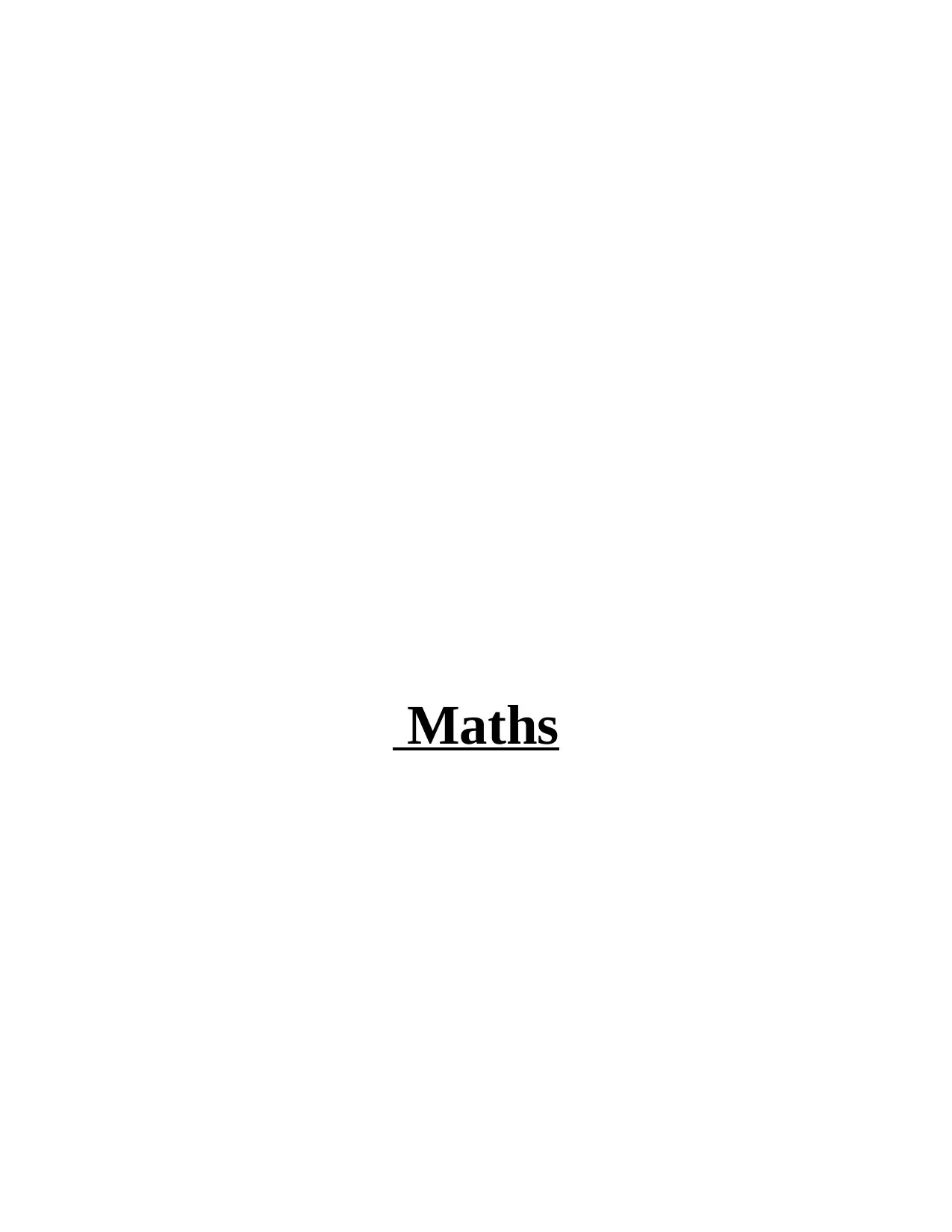
Maths
Paraphrase This Document
Need a fresh take? Get an instant paraphrase of this document with our AI Paraphraser
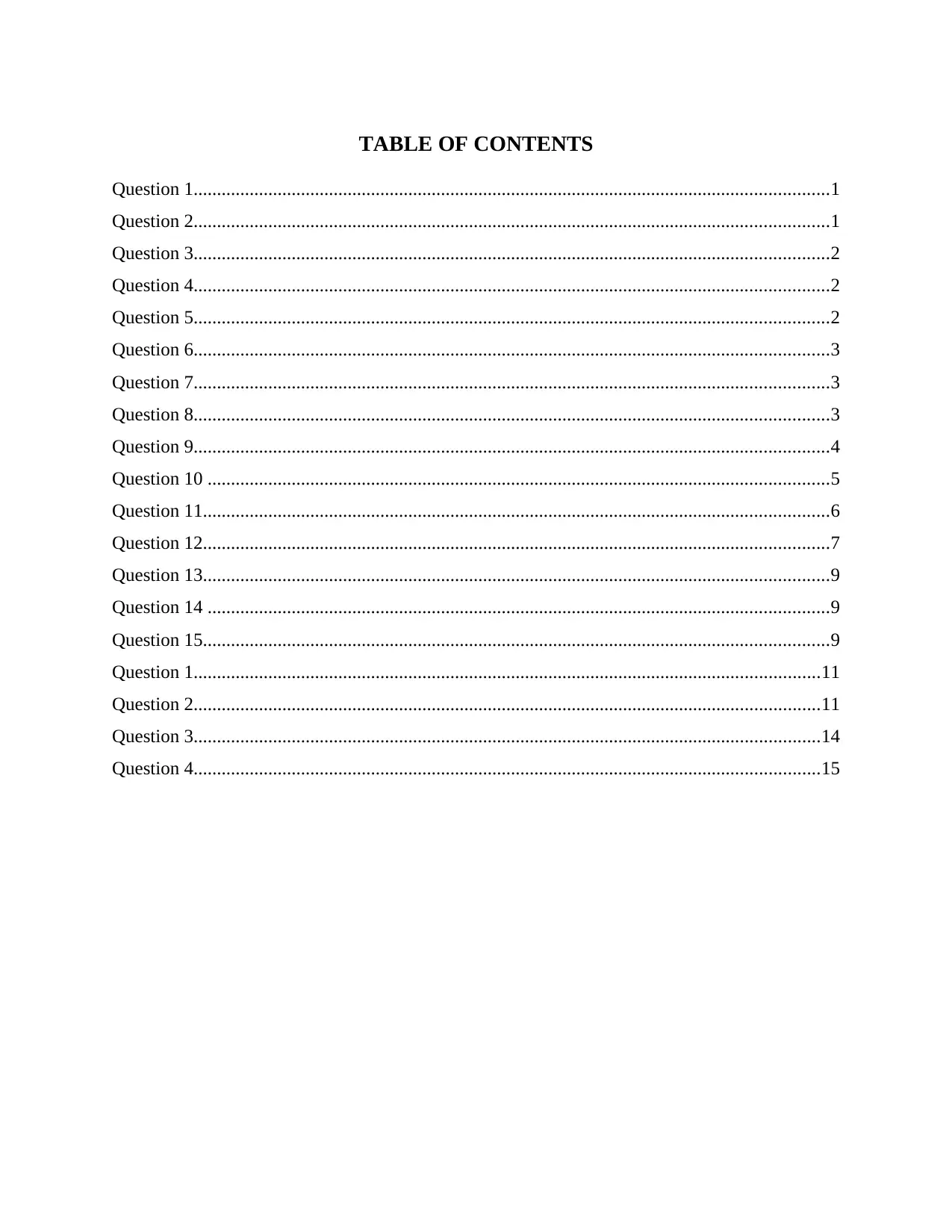
TABLE OF CONTENTS
Question 1........................................................................................................................................1
Question 2........................................................................................................................................1
Question 3........................................................................................................................................2
Question 4........................................................................................................................................2
Question 5........................................................................................................................................2
Question 6........................................................................................................................................3
Question 7........................................................................................................................................3
Question 8........................................................................................................................................3
Question 9........................................................................................................................................4
Question 10 .....................................................................................................................................5
Question 11......................................................................................................................................6
Question 12......................................................................................................................................7
Question 13......................................................................................................................................9
Question 14 .....................................................................................................................................9
Question 15......................................................................................................................................9
Question 1......................................................................................................................................11
Question 2......................................................................................................................................11
Question 3......................................................................................................................................14
Question 4......................................................................................................................................15
Question 1........................................................................................................................................1
Question 2........................................................................................................................................1
Question 3........................................................................................................................................2
Question 4........................................................................................................................................2
Question 5........................................................................................................................................2
Question 6........................................................................................................................................3
Question 7........................................................................................................................................3
Question 8........................................................................................................................................3
Question 9........................................................................................................................................4
Question 10 .....................................................................................................................................5
Question 11......................................................................................................................................6
Question 12......................................................................................................................................7
Question 13......................................................................................................................................9
Question 14 .....................................................................................................................................9
Question 15......................................................................................................................................9
Question 1......................................................................................................................................11
Question 2......................................................................................................................................11
Question 3......................................................................................................................................14
Question 4......................................................................................................................................15
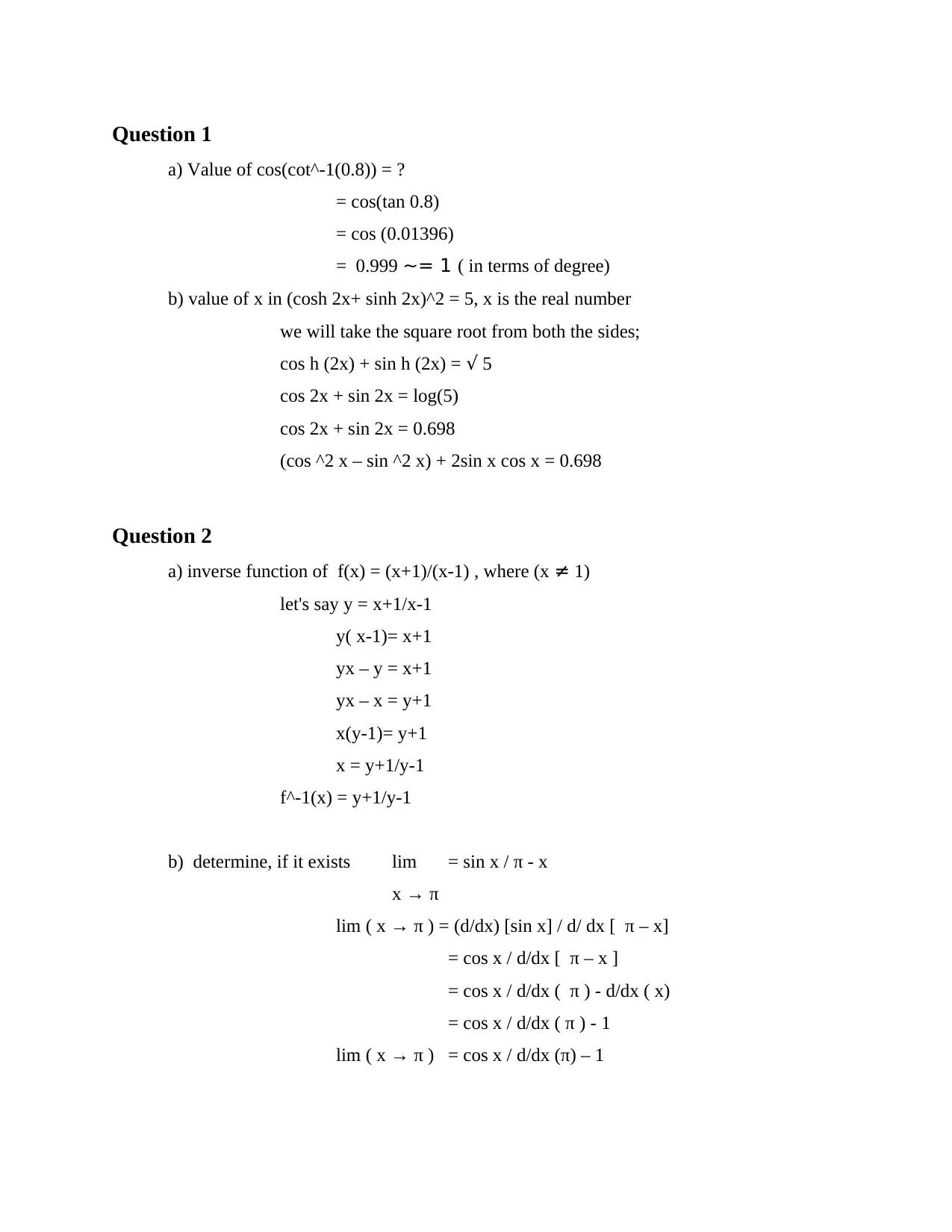
Question 1
a) Value of cos(cot^-1(0.8)) = ?
= cos(tan 0.8)
= cos (0.01396)
= 0.999 ~= 1 ( in terms of degree)
b) value of x in (cosh 2x+ sinh 2x)^2 = 5, x is the real number
we will take the square root from both the sides;
cos h (2x) + sin h (2x) = √ 5
cos 2x + sin 2x = log(5)
cos 2x + sin 2x = 0.698
(cos ^2 x – sin ^2 x) + 2sin x cos x = 0.698
Question 2
a) inverse function of f(x) = (x+1)/(x-1) , where (x ≠ 1)
let's say y = x+1/x-1
y( x-1)= x+1
yx – y = x+1
yx – x = y+1
x(y-1)= y+1
x = y+1/y-1
f^-1(x) = y+1/y-1
b) determine, if it exists lim = sin x / π - x
x → π
lim ( x → π ) = (d/dx) [sin x] / d/ dx [ π – x]
= cos x / d/dx [ π – x ]
= cos x / d/dx ( π ) - d/dx ( x)
= cos x / d/dx ( π ) - 1
lim ( x → π ) = cos x / d/dx (π) – 1
a) Value of cos(cot^-1(0.8)) = ?
= cos(tan 0.8)
= cos (0.01396)
= 0.999 ~= 1 ( in terms of degree)
b) value of x in (cosh 2x+ sinh 2x)^2 = 5, x is the real number
we will take the square root from both the sides;
cos h (2x) + sin h (2x) = √ 5
cos 2x + sin 2x = log(5)
cos 2x + sin 2x = 0.698
(cos ^2 x – sin ^2 x) + 2sin x cos x = 0.698
Question 2
a) inverse function of f(x) = (x+1)/(x-1) , where (x ≠ 1)
let's say y = x+1/x-1
y( x-1)= x+1
yx – y = x+1
yx – x = y+1
x(y-1)= y+1
x = y+1/y-1
f^-1(x) = y+1/y-1
b) determine, if it exists lim = sin x / π - x
x → π
lim ( x → π ) = (d/dx) [sin x] / d/ dx [ π – x]
= cos x / d/dx [ π – x ]
= cos x / d/dx ( π ) - d/dx ( x)
= cos x / d/dx ( π ) - 1
lim ( x → π ) = cos x / d/dx (π) – 1
You're viewing a preview
Unlock full access by subscribing today!
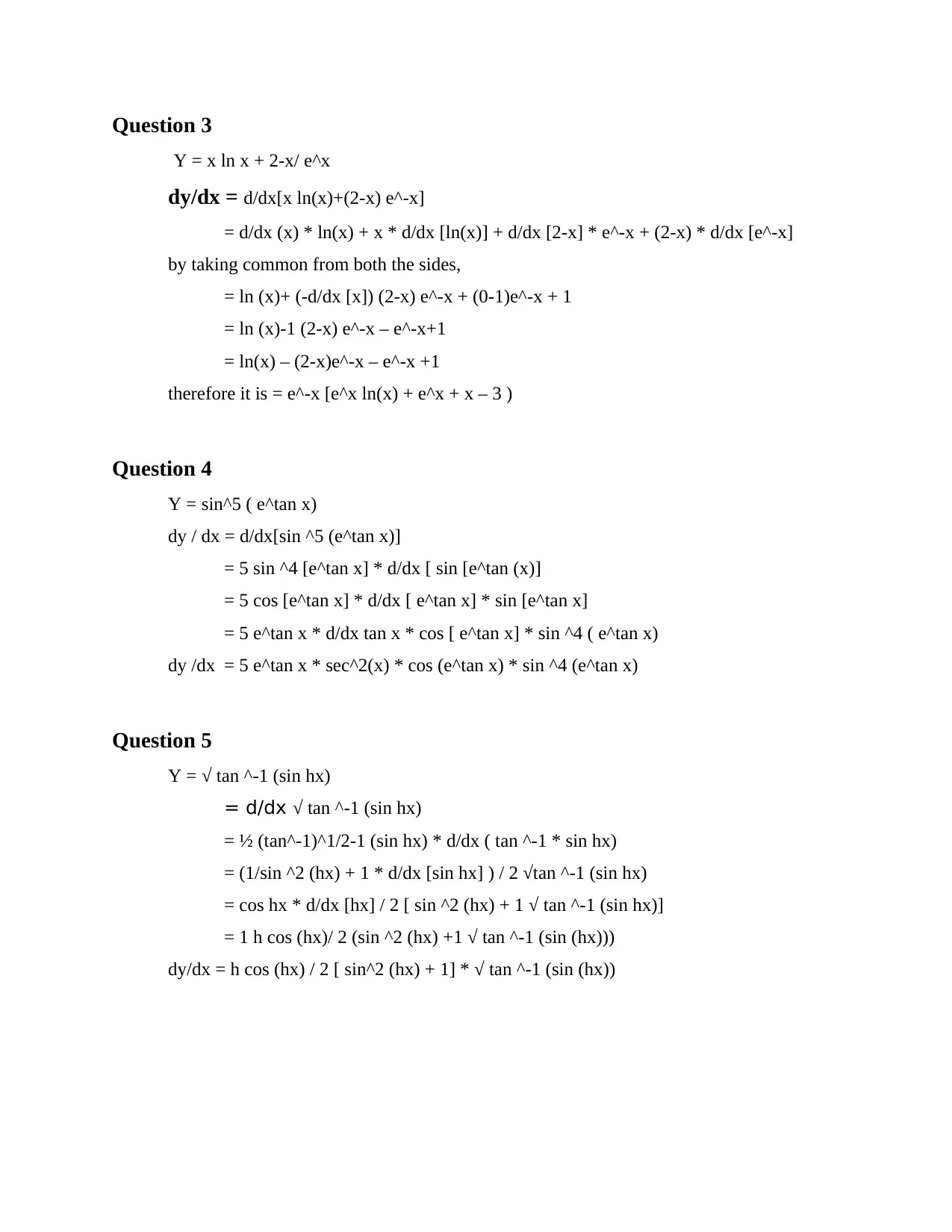
Question 3
Y = x ln x + 2-x/ e^x
dy/dx = d/dx[x ln(x)+(2-x) e^-x]
= d/dx (x) * ln(x) + x * d/dx [ln(x)] + d/dx [2-x] * e^-x + (2-x) * d/dx [e^-x]
by taking common from both the sides,
= ln (x)+ (-d/dx [x]) (2-x) e^-x + (0-1)e^-x + 1
= ln (x)-1 (2-x) e^-x – e^-x+1
= ln(x) – (2-x)e^-x – e^-x +1
therefore it is = e^-x [e^x ln(x) + e^x + x – 3 )
Question 4
Y = sin^5 ( e^tan x)
dy / dx = d/dx[sin ^5 (e^tan x)]
= 5 sin ^4 [e^tan x] * d/dx [ sin [e^tan (x)]
= 5 cos [e^tan x] * d/dx [ e^tan x] * sin [e^tan x]
= 5 e^tan x * d/dx tan x * cos [ e^tan x] * sin ^4 ( e^tan x)
dy /dx = 5 e^tan x * sec^2(x) * cos (e^tan x) * sin ^4 (e^tan x)
Question 5
Y = √ tan ^-1 (sin hx)
= d/dx √ tan ^-1 (sin hx)
= ½ (tan^-1)^1/2-1 (sin hx) * d/dx ( tan ^-1 * sin hx)
= (1/sin ^2 (hx) + 1 * d/dx [sin hx] ) / 2 √tan ^-1 (sin hx)
= cos hx * d/dx [hx] / 2 [ sin ^2 (hx) + 1 √ tan ^-1 (sin hx)]
= 1 h cos (hx)/ 2 (sin ^2 (hx) +1 √ tan ^-1 (sin (hx)))
dy/dx = h cos (hx) / 2 [ sin^2 (hx) + 1] * √ tan ^-1 (sin (hx))
Y = x ln x + 2-x/ e^x
dy/dx = d/dx[x ln(x)+(2-x) e^-x]
= d/dx (x) * ln(x) + x * d/dx [ln(x)] + d/dx [2-x] * e^-x + (2-x) * d/dx [e^-x]
by taking common from both the sides,
= ln (x)+ (-d/dx [x]) (2-x) e^-x + (0-1)e^-x + 1
= ln (x)-1 (2-x) e^-x – e^-x+1
= ln(x) – (2-x)e^-x – e^-x +1
therefore it is = e^-x [e^x ln(x) + e^x + x – 3 )
Question 4
Y = sin^5 ( e^tan x)
dy / dx = d/dx[sin ^5 (e^tan x)]
= 5 sin ^4 [e^tan x] * d/dx [ sin [e^tan (x)]
= 5 cos [e^tan x] * d/dx [ e^tan x] * sin [e^tan x]
= 5 e^tan x * d/dx tan x * cos [ e^tan x] * sin ^4 ( e^tan x)
dy /dx = 5 e^tan x * sec^2(x) * cos (e^tan x) * sin ^4 (e^tan x)
Question 5
Y = √ tan ^-1 (sin hx)
= d/dx √ tan ^-1 (sin hx)
= ½ (tan^-1)^1/2-1 (sin hx) * d/dx ( tan ^-1 * sin hx)
= (1/sin ^2 (hx) + 1 * d/dx [sin hx] ) / 2 √tan ^-1 (sin hx)
= cos hx * d/dx [hx] / 2 [ sin ^2 (hx) + 1 √ tan ^-1 (sin hx)]
= 1 h cos (hx)/ 2 (sin ^2 (hx) +1 √ tan ^-1 (sin (hx)))
dy/dx = h cos (hx) / 2 [ sin^2 (hx) + 1] * √ tan ^-1 (sin (hx))
Paraphrase This Document
Need a fresh take? Get an instant paraphrase of this document with our AI Paraphraser
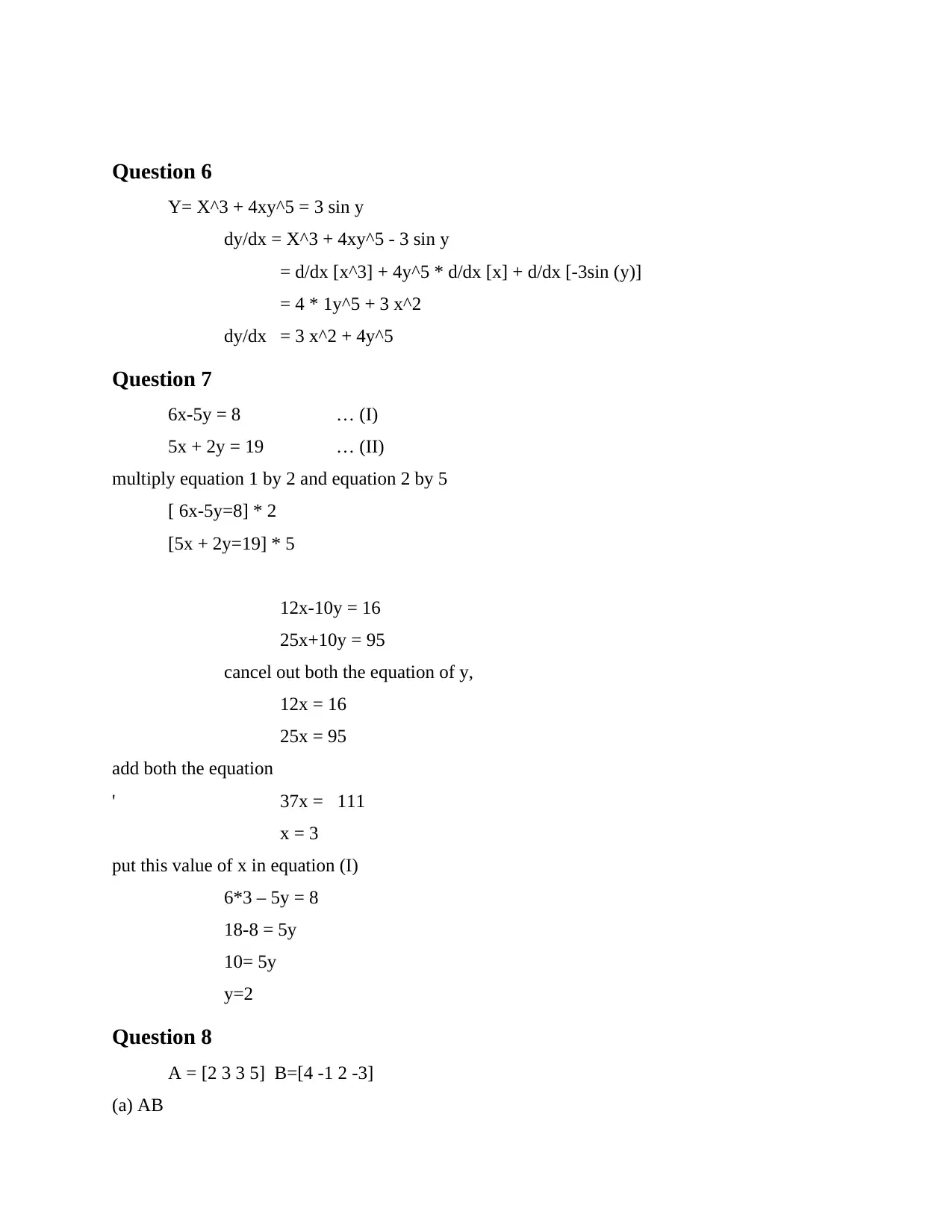
Question 6
Y= X^3 + 4xy^5 = 3 sin y
dy/dx = X^3 + 4xy^5 - 3 sin y
= d/dx [x^3] + 4y^5 * d/dx [x] + d/dx [-3sin (y)]
= 4 * 1y^5 + 3 x^2
dy/dx = 3 x^2 + 4y^5
Question 7
6x-5y = 8 … (I)
5x + 2y = 19 … (II)
multiply equation 1 by 2 and equation 2 by 5
[ 6x-5y=8] * 2
[5x + 2y=19] * 5
12x-10y = 16
25x+10y = 95
cancel out both the equation of y,
12x = 16
25x = 95
add both the equation
' 37x = 111
x = 3
put this value of x in equation (I)
6*3 – 5y = 8
18-8 = 5y
10= 5y
y=2
Question 8
A = [2 3 3 5] B=[4 -1 2 -3]
(a) AB
Y= X^3 + 4xy^5 = 3 sin y
dy/dx = X^3 + 4xy^5 - 3 sin y
= d/dx [x^3] + 4y^5 * d/dx [x] + d/dx [-3sin (y)]
= 4 * 1y^5 + 3 x^2
dy/dx = 3 x^2 + 4y^5
Question 7
6x-5y = 8 … (I)
5x + 2y = 19 … (II)
multiply equation 1 by 2 and equation 2 by 5
[ 6x-5y=8] * 2
[5x + 2y=19] * 5
12x-10y = 16
25x+10y = 95
cancel out both the equation of y,
12x = 16
25x = 95
add both the equation
' 37x = 111
x = 3
put this value of x in equation (I)
6*3 – 5y = 8
18-8 = 5y
10= 5y
y=2
Question 8
A = [2 3 3 5] B=[4 -1 2 -3]
(a) AB
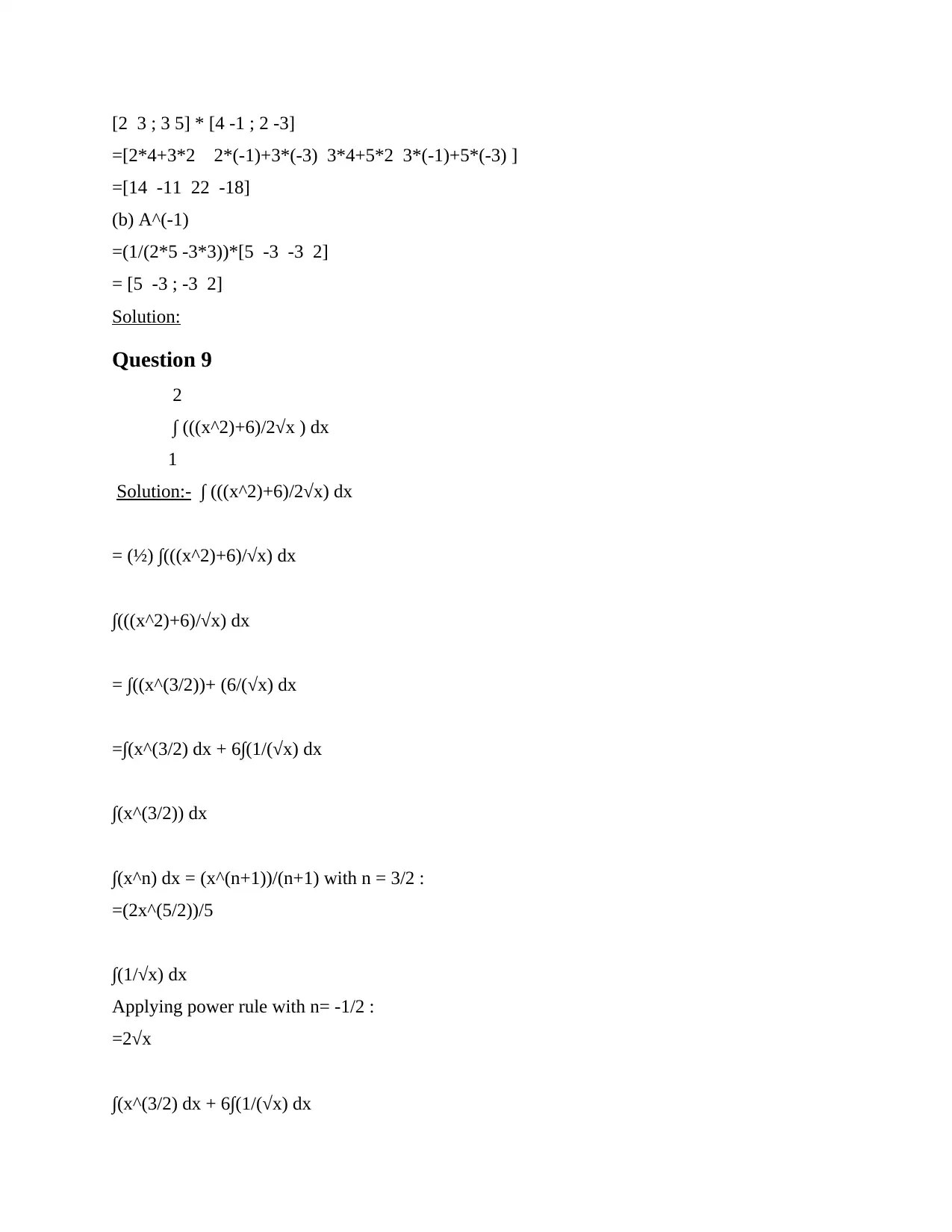
[2 3 ; 3 5] * [4 -1 ; 2 -3]
=[2*4+3*2 2*(-1)+3*(-3) 3*4+5*2 3*(-1)+5*(-3) ]
=[14 -11 22 -18]
(b) A^(-1)
=(1/(2*5 -3*3))*[5 -3 -3 2]
= [5 -3 ; -3 2]
Solution:
Question 9
2
∫ (((x^2)+6)/2√x ) dx
1
Solution:- ∫ (((x^2)+6)/2√x) dx
= (½) ∫(((x^2)+6)/√x) dx
∫(((x^2)+6)/√x) dx
= ∫((x^(3/2))+ (6/(√x) dx
=∫(x^(3/2) dx + 6∫(1/(√x) dx
∫(x^(3/2)) dx
∫(x^n) dx = (x^(n+1))/(n+1) with n = 3/2 :
=(2x^(5/2))/5
∫(1/√x) dx
Applying power rule with n= -1/2 :
=2√x
∫(x^(3/2) dx + 6∫(1/(√x) dx
=[2*4+3*2 2*(-1)+3*(-3) 3*4+5*2 3*(-1)+5*(-3) ]
=[14 -11 22 -18]
(b) A^(-1)
=(1/(2*5 -3*3))*[5 -3 -3 2]
= [5 -3 ; -3 2]
Solution:
Question 9
2
∫ (((x^2)+6)/2√x ) dx
1
Solution:- ∫ (((x^2)+6)/2√x) dx
= (½) ∫(((x^2)+6)/√x) dx
∫(((x^2)+6)/√x) dx
= ∫((x^(3/2))+ (6/(√x) dx
=∫(x^(3/2) dx + 6∫(1/(√x) dx
∫(x^(3/2)) dx
∫(x^n) dx = (x^(n+1))/(n+1) with n = 3/2 :
=(2x^(5/2))/5
∫(1/√x) dx
Applying power rule with n= -1/2 :
=2√x
∫(x^(3/2) dx + 6∫(1/(√x) dx
You're viewing a preview
Unlock full access by subscribing today!
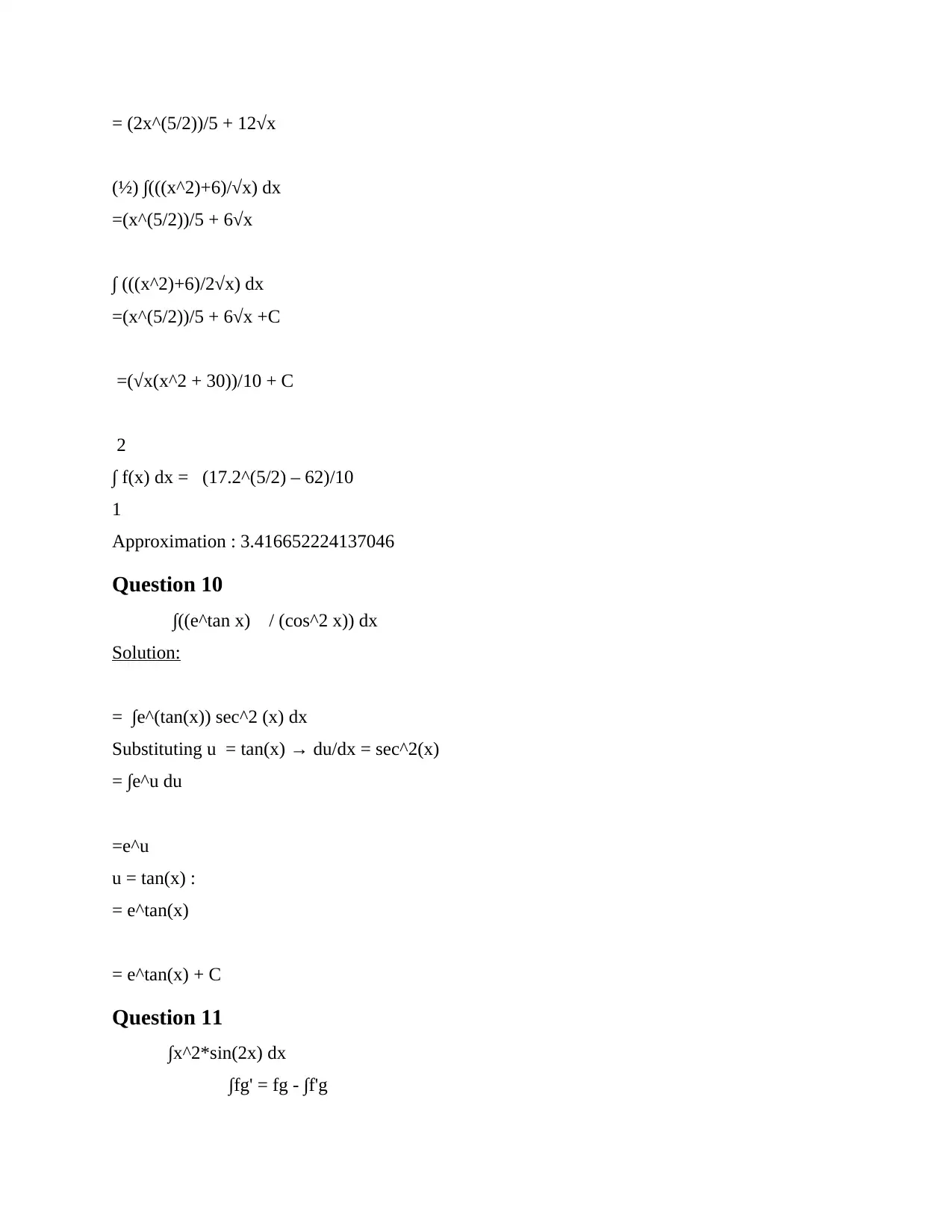
= (2x^(5/2))/5 + 12√x
(½) ∫(((x^2)+6)/√x) dx
=(x^(5/2))/5 + 6√x
∫ (((x^2)+6)/2√x) dx
=(x^(5/2))/5 + 6√x +C
=(√x(x^2 + 30))/10 + C
2
∫ f(x) dx = (17.2^(5/2) – 62)/10
1
Approximation : 3.416652224137046
Question 10
∫((e^tan x) / (cos^2 x)) dx
Solution:
= ∫e^(tan(x)) sec^2 (x) dx
Substituting u = tan(x) → du/dx = sec^2(x)
= ∫e^u du
=e^u
u = tan(x) :
= e^tan(x)
= e^tan(x) + C
Question 11
∫x^2*sin(2x) dx
∫fg' = fg - ∫f'g
(½) ∫(((x^2)+6)/√x) dx
=(x^(5/2))/5 + 6√x
∫ (((x^2)+6)/2√x) dx
=(x^(5/2))/5 + 6√x +C
=(√x(x^2 + 30))/10 + C
2
∫ f(x) dx = (17.2^(5/2) – 62)/10
1
Approximation : 3.416652224137046
Question 10
∫((e^tan x) / (cos^2 x)) dx
Solution:
= ∫e^(tan(x)) sec^2 (x) dx
Substituting u = tan(x) → du/dx = sec^2(x)
= ∫e^u du
=e^u
u = tan(x) :
= e^tan(x)
= e^tan(x) + C
Question 11
∫x^2*sin(2x) dx
∫fg' = fg - ∫f'g
Paraphrase This Document
Need a fresh take? Get an instant paraphrase of this document with our AI Paraphraser
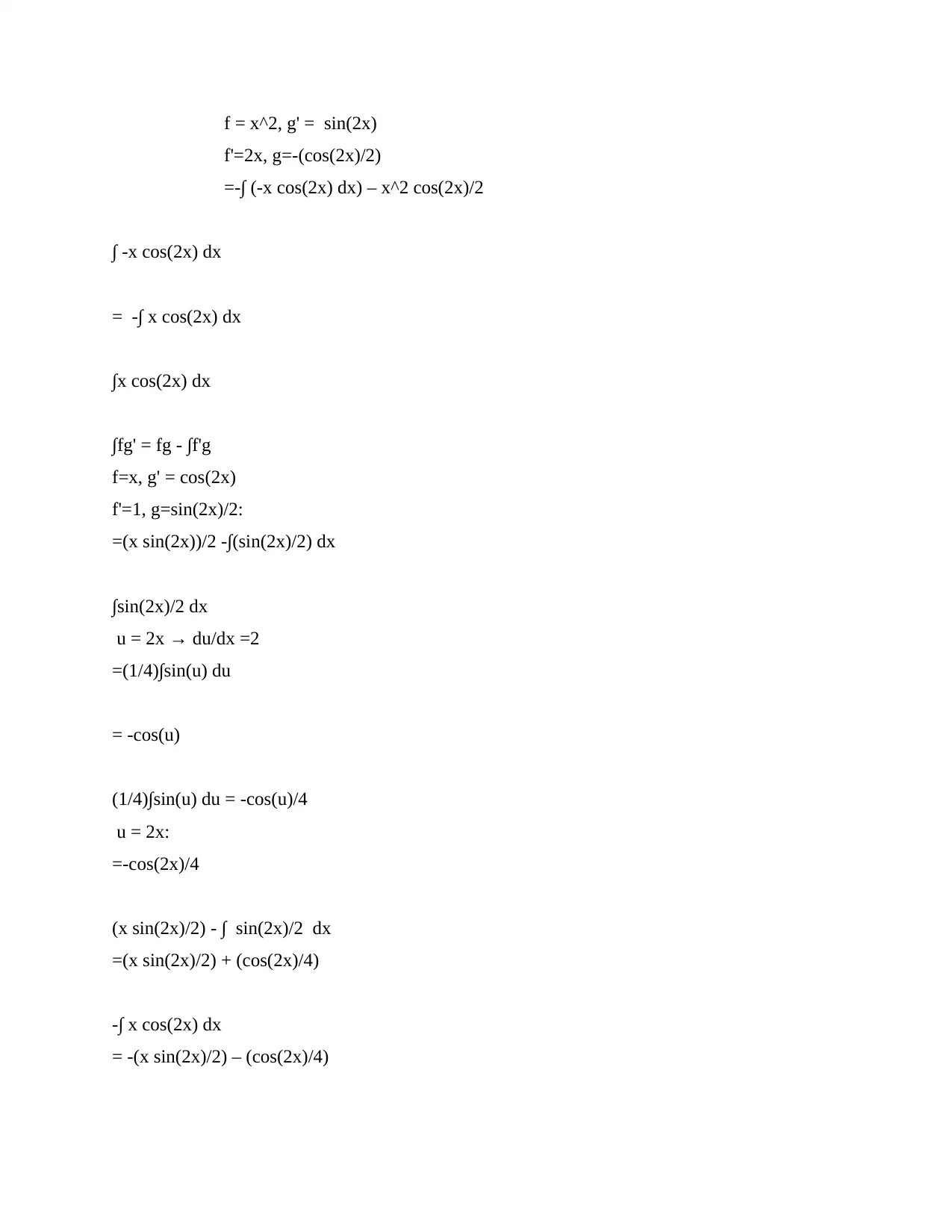
f = x^2, g' = sin(2x)
f'=2x, g=-(cos(2x)/2)
=-∫ (-x cos(2x) dx) – x^2 cos(2x)/2
∫ -x cos(2x) dx
= -∫ x cos(2x) dx
∫x cos(2x) dx
∫fg' = fg - ∫f'g
f=x, g' = cos(2x)
f'=1, g=sin(2x)/2:
=(x sin(2x))/2 -∫(sin(2x)/2) dx
∫sin(2x)/2 dx
u = 2x → du/dx =2
=(1/4)∫sin(u) du
= -cos(u)
(1/4)∫sin(u) du = -cos(u)/4
u = 2x:
=-cos(2x)/4
(x sin(2x)/2) - ∫ sin(2x)/2 dx
=(x sin(2x)/2) + (cos(2x)/4)
-∫ x cos(2x) dx
= -(x sin(2x)/2) – (cos(2x)/4)
f'=2x, g=-(cos(2x)/2)
=-∫ (-x cos(2x) dx) – x^2 cos(2x)/2
∫ -x cos(2x) dx
= -∫ x cos(2x) dx
∫x cos(2x) dx
∫fg' = fg - ∫f'g
f=x, g' = cos(2x)
f'=1, g=sin(2x)/2:
=(x sin(2x))/2 -∫(sin(2x)/2) dx
∫sin(2x)/2 dx
u = 2x → du/dx =2
=(1/4)∫sin(u) du
= -cos(u)
(1/4)∫sin(u) du = -cos(u)/4
u = 2x:
=-cos(2x)/4
(x sin(2x)/2) - ∫ sin(2x)/2 dx
=(x sin(2x)/2) + (cos(2x)/4)
-∫ x cos(2x) dx
= -(x sin(2x)/2) – (cos(2x)/4)
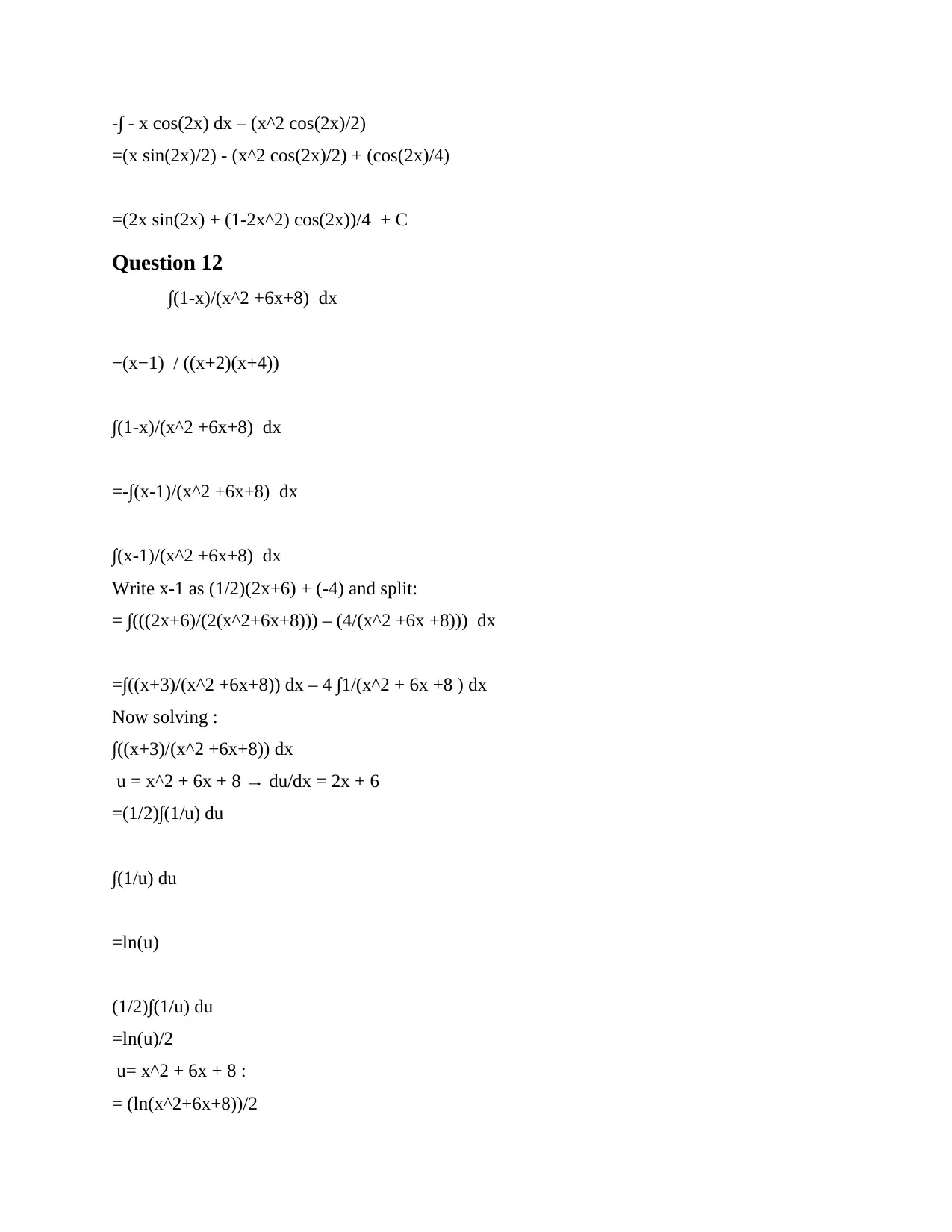
-∫ - x cos(2x) dx – (x^2 cos(2x)/2)
=(x sin(2x)/2) - (x^2 cos(2x)/2) + (cos(2x)/4)
=(2x sin(2x) + (1-2x^2) cos(2x))/4 + C
Question 12
∫(1-x)/(x^2 +6x+8) dx
−(x−1) / ((x+2)(x+4))
∫(1-x)/(x^2 +6x+8) dx
=-∫(x-1)/(x^2 +6x+8) dx
∫(x-1)/(x^2 +6x+8) dx
Write x-1 as (1/2)(2x+6) + (-4) and split:
= ∫(((2x+6)/(2(x^2+6x+8))) – (4/(x^2 +6x +8))) dx
=∫((x+3)/(x^2 +6x+8)) dx – 4 ∫1/(x^2 + 6x +8 ) dx
Now solving :
∫((x+3)/(x^2 +6x+8)) dx
u = x^2 + 6x + 8 → du/dx = 2x + 6
=(1/2)∫(1/u) du
∫(1/u) du
=ln(u)
(1/2)∫(1/u) du
=ln(u)/2
u= x^2 + 6x + 8 :
= (ln(x^2+6x+8))/2
=(x sin(2x)/2) - (x^2 cos(2x)/2) + (cos(2x)/4)
=(2x sin(2x) + (1-2x^2) cos(2x))/4 + C
Question 12
∫(1-x)/(x^2 +6x+8) dx
−(x−1) / ((x+2)(x+4))
∫(1-x)/(x^2 +6x+8) dx
=-∫(x-1)/(x^2 +6x+8) dx
∫(x-1)/(x^2 +6x+8) dx
Write x-1 as (1/2)(2x+6) + (-4) and split:
= ∫(((2x+6)/(2(x^2+6x+8))) – (4/(x^2 +6x +8))) dx
=∫((x+3)/(x^2 +6x+8)) dx – 4 ∫1/(x^2 + 6x +8 ) dx
Now solving :
∫((x+3)/(x^2 +6x+8)) dx
u = x^2 + 6x + 8 → du/dx = 2x + 6
=(1/2)∫(1/u) du
∫(1/u) du
=ln(u)
(1/2)∫(1/u) du
=ln(u)/2
u= x^2 + 6x + 8 :
= (ln(x^2+6x+8))/2
You're viewing a preview
Unlock full access by subscribing today!

∫1/(x^2+6x+8) dx
Factor the denominator :
= ∫1/((x+2)(x+4)) dx
partial-fraction decomposing :
=∫((1/(2(x+2)) – (1/(2(x+4))) dx
=(1/2) ∫(1/(x+2)) dx – (1/2)∫(1/(x+4)) dx
∫(1/(x+4)) dx
u=x+4 → du/dx = 1
=∫(1/u)du
=ln(u)
u= x+4:
=ln(x+4)
∫(1/(x+2)) dx
u= x+2 → du/dx =1
=∫(1/u)du
=ln(u)
u= x+2:
=ln(x+2)
=ln(x^2+6x+8) /2 + 2ln(x+4) – 2ln(x+2)
Rewriting & simplyfying furthermore
= -(ln(x^2+6x+8)/2 – 2ln(x+4) + 2 ln( x+2)
= -(5 ln( |x+4| ) - 3 ln(|x+2|)/2 + C
Question 13
∫(1/((8-x^2-2x)^(1/2)) ) dx
Solution:
Factor the denominator :
= ∫1/((x+2)(x+4)) dx
partial-fraction decomposing :
=∫((1/(2(x+2)) – (1/(2(x+4))) dx
=(1/2) ∫(1/(x+2)) dx – (1/2)∫(1/(x+4)) dx
∫(1/(x+4)) dx
u=x+4 → du/dx = 1
=∫(1/u)du
=ln(u)
u= x+4:
=ln(x+4)
∫(1/(x+2)) dx
u= x+2 → du/dx =1
=∫(1/u)du
=ln(u)
u= x+2:
=ln(x+2)
=ln(x^2+6x+8) /2 + 2ln(x+4) – 2ln(x+2)
Rewriting & simplyfying furthermore
= -(ln(x^2+6x+8)/2 – 2ln(x+4) + 2 ln( x+2)
= -(5 ln( |x+4| ) - 3 ln(|x+2|)/2 + C
Question 13
∫(1/((8-x^2-2x)^(1/2)) ) dx
Solution:
Paraphrase This Document
Need a fresh take? Get an instant paraphrase of this document with our AI Paraphraser
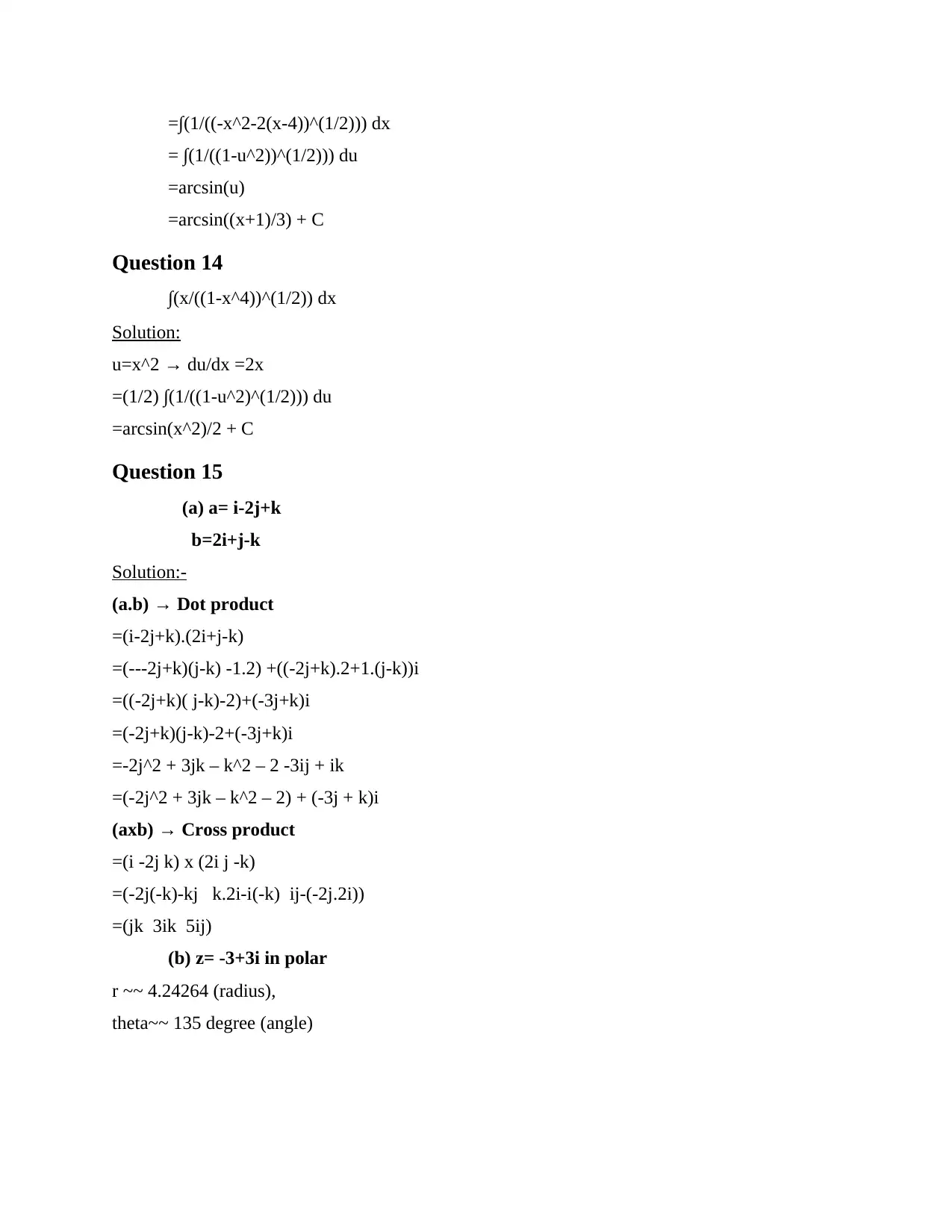
=∫(1/((-x^2-2(x-4))^(1/2))) dx
= ∫(1/((1-u^2))^(1/2))) du
=arcsin(u)
=arcsin((x+1)/3) + C
Question 14
∫(x/((1-x^4))^(1/2)) dx
Solution:
u=x^2 → du/dx =2x
=(1/2) ∫(1/((1-u^2)^(1/2))) du
=arcsin(x^2)/2 + C
Question 15
(a) a= i-2j+k
b=2i+j-k
Solution:-
(a.b) → Dot product
=(i-2j+k).(2i+j-k)
=(---2j+k)(j-k) -1.2) +((-2j+k).2+1.(j-k))i
=((-2j+k)( j-k)-2)+(-3j+k)i
=(-2j+k)(j-k)-2+(-3j+k)i
=-2j^2 + 3jk – k^2 – 2 -3ij + ik
=(-2j^2 + 3jk – k^2 – 2) + (-3j + k)i
(axb) → Cross product
=(i -2j k) x (2i j -k)
=(-2j(-k)-kj k.2i-i(-k) ij-(-2j.2i))
=(jk 3ik 5ij)
(b) z= -3+3i in polar
r ~~ 4.24264 (radius),
theta~~ 135 degree (angle)
= ∫(1/((1-u^2))^(1/2))) du
=arcsin(u)
=arcsin((x+1)/3) + C
Question 14
∫(x/((1-x^4))^(1/2)) dx
Solution:
u=x^2 → du/dx =2x
=(1/2) ∫(1/((1-u^2)^(1/2))) du
=arcsin(x^2)/2 + C
Question 15
(a) a= i-2j+k
b=2i+j-k
Solution:-
(a.b) → Dot product
=(i-2j+k).(2i+j-k)
=(---2j+k)(j-k) -1.2) +((-2j+k).2+1.(j-k))i
=((-2j+k)( j-k)-2)+(-3j+k)i
=(-2j+k)(j-k)-2+(-3j+k)i
=-2j^2 + 3jk – k^2 – 2 -3ij + ik
=(-2j^2 + 3jk – k^2 – 2) + (-3j + k)i
(axb) → Cross product
=(i -2j k) x (2i j -k)
=(-2j(-k)-kj k.2i-i(-k) ij-(-2j.2i))
=(jk 3ik 5ij)
(b) z= -3+3i in polar
r ~~ 4.24264 (radius),
theta~~ 135 degree (angle)
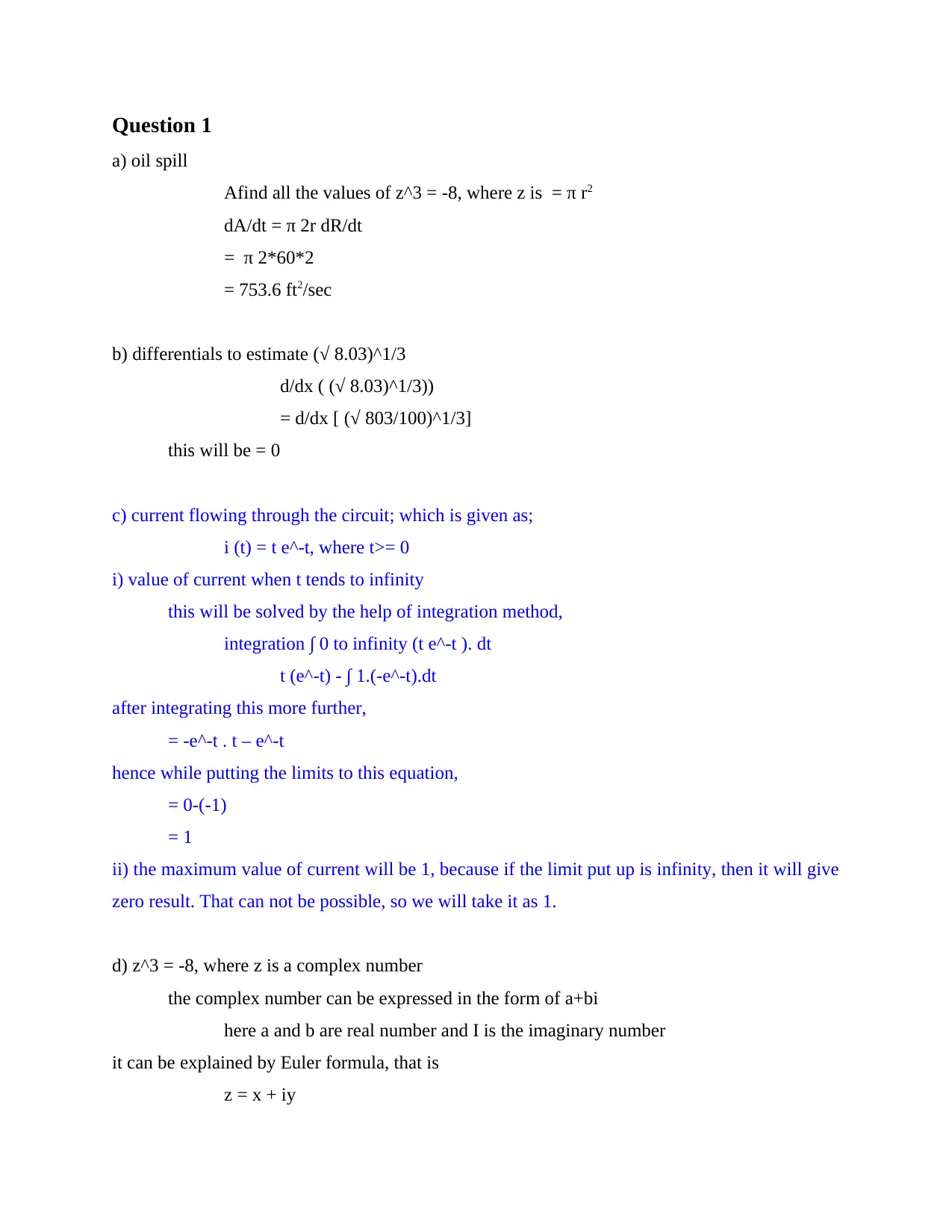
Question 1
a) oil spill
Afind all the values of z^3 = -8, where z is = π r2
dA/dt = π 2r dR/dt
= π 2*60*2
= 753.6 ft2/sec
b) differentials to estimate (√ 8.03)^1/3
d/dx ( (√ 8.03)^1/3))
= d/dx [ (√ 803/100)^1/3]
this will be = 0
c) current flowing through the circuit; which is given as;
i (t) = t e^-t, where t>= 0
i) value of current when t tends to infinity
this will be solved by the help of integration method,
integration ∫ 0 to infinity (t e^-t ). dt
t (e^-t) - ∫ 1.(-e^-t).dt
after integrating this more further,
= -e^-t . t – e^-t
hence while putting the limits to this equation,
= 0-(-1)
= 1
ii) the maximum value of current will be 1, because if the limit put up is infinity, then it will give
zero result. That can not be possible, so we will take it as 1.
d) z^3 = -8, where z is a complex number
the complex number can be expressed in the form of a+bi
here a and b are real number and I is the imaginary number
it can be explained by Euler formula, that is
z = x + iy
a) oil spill
Afind all the values of z^3 = -8, where z is = π r2
dA/dt = π 2r dR/dt
= π 2*60*2
= 753.6 ft2/sec
b) differentials to estimate (√ 8.03)^1/3
d/dx ( (√ 8.03)^1/3))
= d/dx [ (√ 803/100)^1/3]
this will be = 0
c) current flowing through the circuit; which is given as;
i (t) = t e^-t, where t>= 0
i) value of current when t tends to infinity
this will be solved by the help of integration method,
integration ∫ 0 to infinity (t e^-t ). dt
t (e^-t) - ∫ 1.(-e^-t).dt
after integrating this more further,
= -e^-t . t – e^-t
hence while putting the limits to this equation,
= 0-(-1)
= 1
ii) the maximum value of current will be 1, because if the limit put up is infinity, then it will give
zero result. That can not be possible, so we will take it as 1.
d) z^3 = -8, where z is a complex number
the complex number can be expressed in the form of a+bi
here a and b are real number and I is the imaginary number
it can be explained by Euler formula, that is
z = x + iy
You're viewing a preview
Unlock full access by subscribing today!

here, z = x + (-8)^(1/3) * y
the solutions can not be restricted, because the value of iota (i) can be varied from negative
infinity to positive infinity.
Question 2
a) Question 2
(a) [ X ; Y ; Z] = [1.0 0.1 0 ; 0.5 1.0 0.1 ; 0.3 0.4 1.0] [x ; y ; z]
After multiplying equations will be
1.0x+0.1y =X
0.5x+1.0y+0.1z=Y
0.3x+0.4y+1.0z=Z
Substituting values of X, Y and Z
1.0x+0.1y =0.1 → (1)
0.5x+1.0y+0.1z=0.2 → (2)
0.3x+0.4y+1.0z=0.1 → (3)
Solving by cramer's rule :-
Δ = [1 0.1 0 ; 0.5 1 0.1 ; 0.3 0.4 1] = 0.913
Δ1 = [0.1 0.1 0 ; 0.2 1 0.1 ; 0.1 0.4 1] = 0.077
Δ2 = [1 0.1 0 ; 0.5 0.2 0.1 ; 0.3 0.1 1] = 0.143
Δ3 = [1 0.1 0.1 ; 0.5 1 0.2 ; 0.3 0.4 0.1] = 0.011
x = Δ1/Δ =0.077/0.913=0.0843
y = Δ2/Δ = 0.143/0.913 =0.1566
z= Δ3/Δ = 0.011/0.913 =0.01204
(b) Eigen values and eigen vectyors for A=[1 3 ; 2 2]
1. Eigen values
[1- λ 3 ; 2 2-λ] = λ^2 -3* λ – 4
=( λ+1)( λ-4)
λ1 = -1
λ2 = 4
2. Eigen vectors
(1) λ1=-1
By Gaussian elimination method
the solutions can not be restricted, because the value of iota (i) can be varied from negative
infinity to positive infinity.
Question 2
a) Question 2
(a) [ X ; Y ; Z] = [1.0 0.1 0 ; 0.5 1.0 0.1 ; 0.3 0.4 1.0] [x ; y ; z]
After multiplying equations will be
1.0x+0.1y =X
0.5x+1.0y+0.1z=Y
0.3x+0.4y+1.0z=Z
Substituting values of X, Y and Z
1.0x+0.1y =0.1 → (1)
0.5x+1.0y+0.1z=0.2 → (2)
0.3x+0.4y+1.0z=0.1 → (3)
Solving by cramer's rule :-
Δ = [1 0.1 0 ; 0.5 1 0.1 ; 0.3 0.4 1] = 0.913
Δ1 = [0.1 0.1 0 ; 0.2 1 0.1 ; 0.1 0.4 1] = 0.077
Δ2 = [1 0.1 0 ; 0.5 0.2 0.1 ; 0.3 0.1 1] = 0.143
Δ3 = [1 0.1 0.1 ; 0.5 1 0.2 ; 0.3 0.4 0.1] = 0.011
x = Δ1/Δ =0.077/0.913=0.0843
y = Δ2/Δ = 0.143/0.913 =0.1566
z= Δ3/Δ = 0.011/0.913 =0.01204
(b) Eigen values and eigen vectyors for A=[1 3 ; 2 2]
1. Eigen values
[1- λ 3 ; 2 2-λ] = λ^2 -3* λ – 4
=( λ+1)( λ-4)
λ1 = -1
λ2 = 4
2. Eigen vectors
(1) λ1=-1
By Gaussian elimination method
Paraphrase This Document
Need a fresh take? Get an instant paraphrase of this document with our AI Paraphraser

x1 + (3/2)x2 = 0 → (1)
x1=(-3/2 )* x2 = (-3/2) * x2
X=[ (-3/2)*x2 ; x2]
(2) λ2 = 4
By Gaussian elimination method
x1 – x2 = 0 → (1)
X=[x2 ; x2]
c) probability distribution of sample
x = 5 6 7 8
p = 0.17 0.3 0.35 c
the mean can be given as submission of volts / total number
= 5+6+7+8 / 4
= 26/4
= 6.5
variance = [submission of (x)^2 / N] – (mean)^2
= (26)^2/4 – (6.5)^2
= 126.75
d)
x1=(-3/2 )* x2 = (-3/2) * x2
X=[ (-3/2)*x2 ; x2]
(2) λ2 = 4
By Gaussian elimination method
x1 – x2 = 0 → (1)
X=[x2 ; x2]
c) probability distribution of sample
x = 5 6 7 8
p = 0.17 0.3 0.35 c
the mean can be given as submission of volts / total number
= 5+6+7+8 / 4
= 26/4
= 6.5
variance = [submission of (x)^2 / N] – (mean)^2
= (26)^2/4 – (6.5)^2
= 126.75
d)
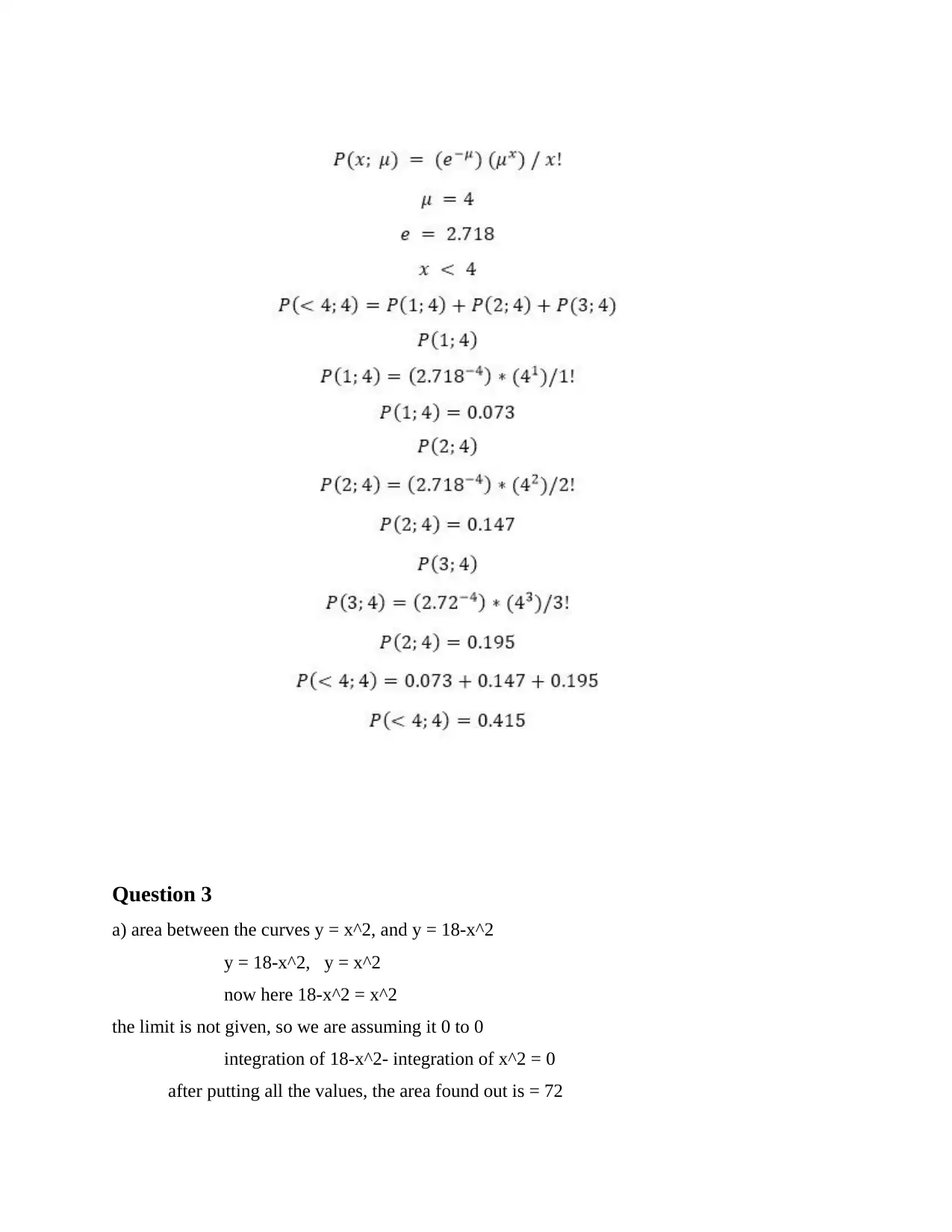
Question 3
a) area between the curves y = x^2, and y = 18-x^2
y = 18-x^2, y = x^2
now here 18-x^2 = x^2
the limit is not given, so we are assuming it 0 to 0
integration of 18-x^2- integration of x^2 = 0
after putting all the values, the area found out is = 72
a) area between the curves y = x^2, and y = 18-x^2
y = 18-x^2, y = x^2
now here 18-x^2 = x^2
the limit is not given, so we are assuming it 0 to 0
integration of 18-x^2- integration of x^2 = 0
after putting all the values, the area found out is = 72
You're viewing a preview
Unlock full access by subscribing today!
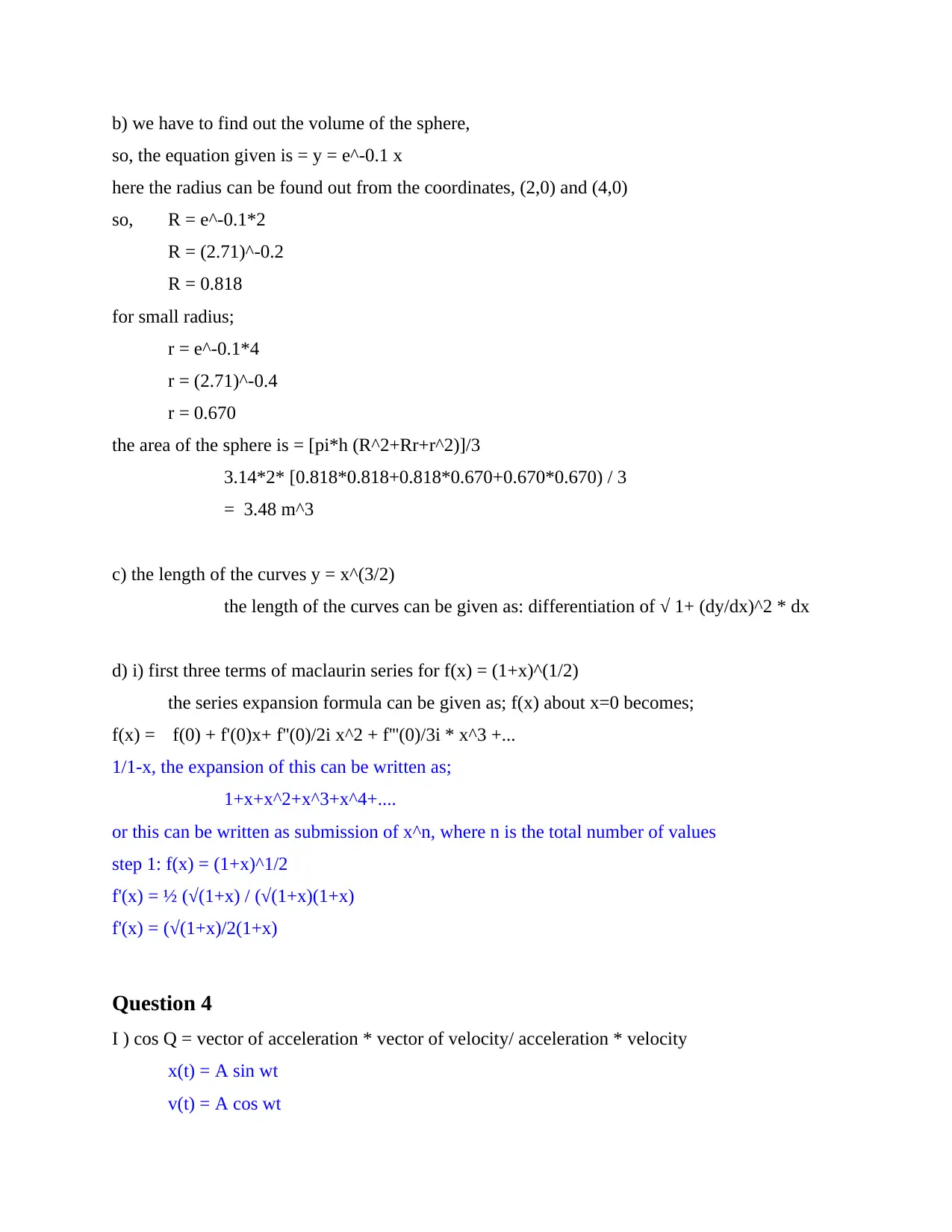
b) we have to find out the volume of the sphere,
so, the equation given is = y = e^-0.1 x
here the radius can be found out from the coordinates, (2,0) and (4,0)
so, R = e^-0.1*2
R = (2.71)^-0.2
R = 0.818
for small radius;
r = e^-0.1*4
r = (2.71)^-0.4
r = 0.670
the area of the sphere is = [pi*h (R^2+Rr+r^2)]/3
3.14*2* [0.818*0.818+0.818*0.670+0.670*0.670) / 3
= 3.48 m^3
c) the length of the curves y = x^(3/2)
the length of the curves can be given as: differentiation of √ 1+ (dy/dx)^2 * dx
d) i) first three terms of maclaurin series for f(x) = (1+x)^(1/2)
the series expansion formula can be given as; f(x) about x=0 becomes;
f(x) = f(0) + f'(0)x+ f''(0)/2i x^2 + f'''(0)/3i * x^3 +...
1/1-x, the expansion of this can be written as;
1+x+x^2+x^3+x^4+....
or this can be written as submission of x^n, where n is the total number of values
step 1: f(x) = (1+x)^1/2
f'(x) = ½ (√(1+x) / (√(1+x)(1+x)
f'(x) = (√(1+x)/2(1+x)
Question 4
I ) cos Q = vector of acceleration * vector of velocity/ acceleration * velocity
x(t) = A sin wt
v(t) = A cos wt
so, the equation given is = y = e^-0.1 x
here the radius can be found out from the coordinates, (2,0) and (4,0)
so, R = e^-0.1*2
R = (2.71)^-0.2
R = 0.818
for small radius;
r = e^-0.1*4
r = (2.71)^-0.4
r = 0.670
the area of the sphere is = [pi*h (R^2+Rr+r^2)]/3
3.14*2* [0.818*0.818+0.818*0.670+0.670*0.670) / 3
= 3.48 m^3
c) the length of the curves y = x^(3/2)
the length of the curves can be given as: differentiation of √ 1+ (dy/dx)^2 * dx
d) i) first three terms of maclaurin series for f(x) = (1+x)^(1/2)
the series expansion formula can be given as; f(x) about x=0 becomes;
f(x) = f(0) + f'(0)x+ f''(0)/2i x^2 + f'''(0)/3i * x^3 +...
1/1-x, the expansion of this can be written as;
1+x+x^2+x^3+x^4+....
or this can be written as submission of x^n, where n is the total number of values
step 1: f(x) = (1+x)^1/2
f'(x) = ½ (√(1+x) / (√(1+x)(1+x)
f'(x) = (√(1+x)/2(1+x)
Question 4
I ) cos Q = vector of acceleration * vector of velocity/ acceleration * velocity
x(t) = A sin wt
v(t) = A cos wt
Paraphrase This Document
Need a fresh take? Get an instant paraphrase of this document with our AI Paraphraser
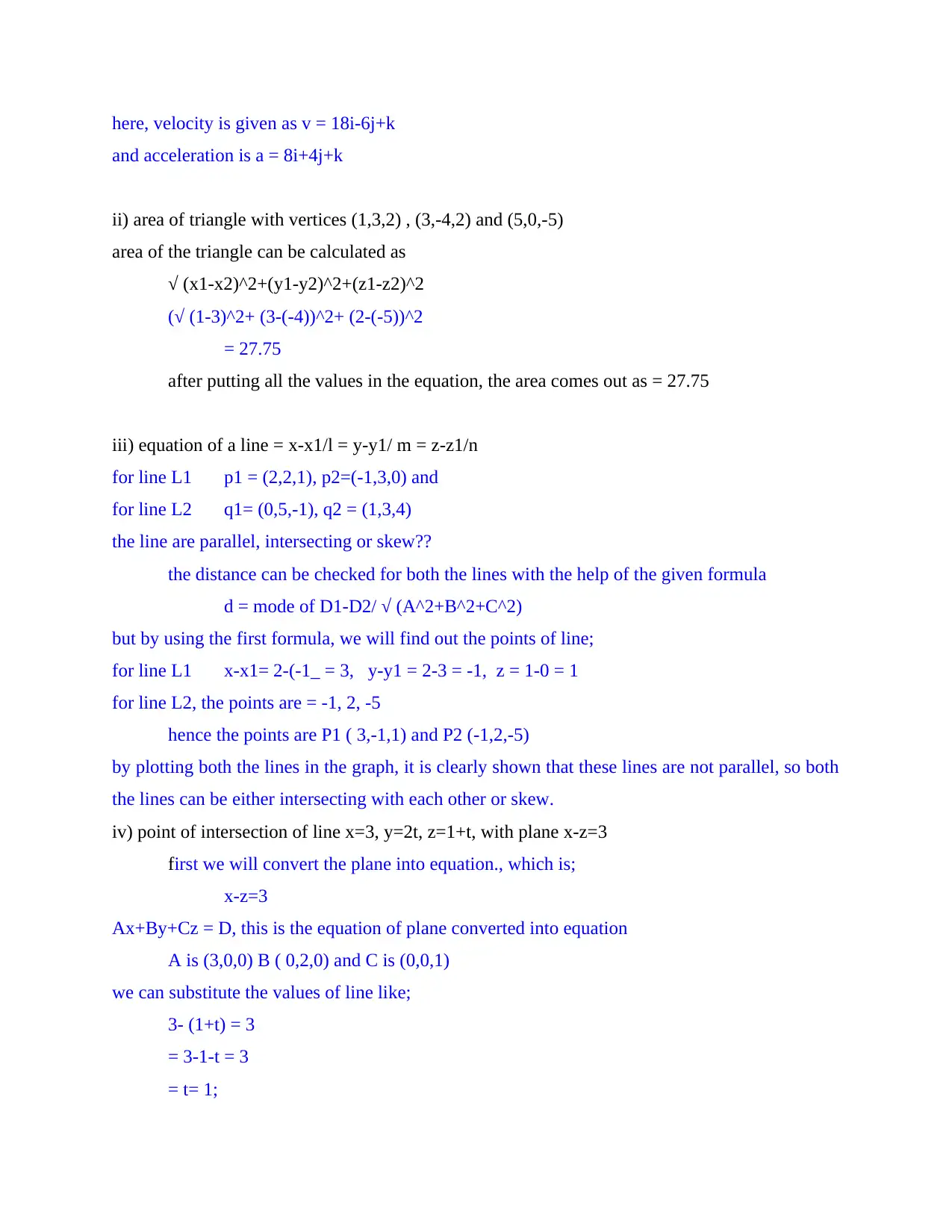
here, velocity is given as v = 18i-6j+k
and acceleration is a = 8i+4j+k
ii) area of triangle with vertices (1,3,2) , (3,-4,2) and (5,0,-5)
area of the triangle can be calculated as
√ (x1-x2)^2+(y1-y2)^2+(z1-z2)^2
(√ (1-3)^2+ (3-(-4))^2+ (2-(-5))^2
= 27.75
after putting all the values in the equation, the area comes out as = 27.75
iii) equation of a line = x-x1/l = y-y1/ m = z-z1/n
for line L1 p1 = (2,2,1), p2=(-1,3,0) and
for line L2 q1= (0,5,-1), q2 = (1,3,4)
the line are parallel, intersecting or skew??
the distance can be checked for both the lines with the help of the given formula
d = mode of D1-D2/ √ (A^2+B^2+C^2)
but by using the first formula, we will find out the points of line;
for line L1 x-x1= 2-(-1_ = 3, y-y1 = 2-3 = -1, z = 1-0 = 1
for line L2, the points are = -1, 2, -5
hence the points are P1 ( 3,-1,1) and P2 (-1,2,-5)
by plotting both the lines in the graph, it is clearly shown that these lines are not parallel, so both
the lines can be either intersecting with each other or skew.
iv) point of intersection of line x=3, y=2t, z=1+t, with plane x-z=3
first we will convert the plane into equation., which is;
x-z=3
Ax+By+Cz = D, this is the equation of plane converted into equation
A is (3,0,0) B ( 0,2,0) and C is (0,0,1)
we can substitute the values of line like;
3- (1+t) = 3
= 3-1-t = 3
= t= 1;
and acceleration is a = 8i+4j+k
ii) area of triangle with vertices (1,3,2) , (3,-4,2) and (5,0,-5)
area of the triangle can be calculated as
√ (x1-x2)^2+(y1-y2)^2+(z1-z2)^2
(√ (1-3)^2+ (3-(-4))^2+ (2-(-5))^2
= 27.75
after putting all the values in the equation, the area comes out as = 27.75
iii) equation of a line = x-x1/l = y-y1/ m = z-z1/n
for line L1 p1 = (2,2,1), p2=(-1,3,0) and
for line L2 q1= (0,5,-1), q2 = (1,3,4)
the line are parallel, intersecting or skew??
the distance can be checked for both the lines with the help of the given formula
d = mode of D1-D2/ √ (A^2+B^2+C^2)
but by using the first formula, we will find out the points of line;
for line L1 x-x1= 2-(-1_ = 3, y-y1 = 2-3 = -1, z = 1-0 = 1
for line L2, the points are = -1, 2, -5
hence the points are P1 ( 3,-1,1) and P2 (-1,2,-5)
by plotting both the lines in the graph, it is clearly shown that these lines are not parallel, so both
the lines can be either intersecting with each other or skew.
iv) point of intersection of line x=3, y=2t, z=1+t, with plane x-z=3
first we will convert the plane into equation., which is;
x-z=3
Ax+By+Cz = D, this is the equation of plane converted into equation
A is (3,0,0) B ( 0,2,0) and C is (0,0,1)
we can substitute the values of line like;
3- (1+t) = 3
= 3-1-t = 3
= t= 1;

hence we can find the values of y and z;
put the value of t in both the equation of y and z.
x=3, y= 2 and z= 2
so the point of intersection is (3,2,2).
put the value of t in both the equation of y and z.
x=3, y= 2 and z= 2
so the point of intersection is (3,2,2).
You're viewing a preview
Unlock full access by subscribing today!
1 out of 18
Related Documents
Your All-in-One AI-Powered Toolkit for Academic Success.
+13062052269
info@desklib.com
Available 24*7 on WhatsApp / Email
![[object Object]](/_next/static/media/star-bottom.7253800d.svg)
Unlock your academic potential
© 2024 | Zucol Services PVT LTD | All rights reserved.





